The Tiber Film company of Rome was founded in 1914 by producer Gioacchino Mecheri (1876-1942). Between 1915 and 1919, Tiber Film rivaled the other Roman company, Caesar Film, run by producer Giuseppe Barattolo. Both companies had a leading diva to profile itself with: Hesperia at Tiber Film, and Francesca Bertini at Caesar.
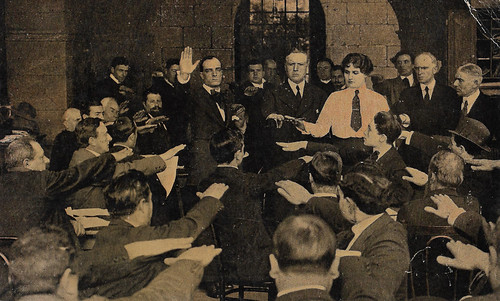
Spanish collectors card by Chocolate Pi, Barcelona, no. 2 of 6. Photo: Tiber Film. Hesperia and Emilio Ghione in Il potere sovrano (Baldassarre Negroni, Percy Nash, 1916).
Il potere sovrano was based on the novel 'Temporal Power' by Marie Corelli. Lotys (Hesperia) is the idol of the people. Therd (Emilio Ghione), a journalist, a man of action, and manager of the paper The Idea, is also beloved by his compatriots. Their ideals unite Lotys and Therd. The King (Ignazio Lupi) lives distanced from his people and has left governing to his ministers. The government threatens Therd with arrest if he doesn't stop his actions.
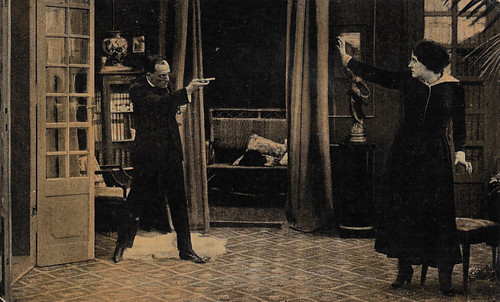
Spanish collectors card by Chocolate Pi, Barcelona, no. 6 of 6. Photo: Tiber Film. Hesperia and Emilio Ghione in Il potere sovrano (Baldassarre Negroni, Percy Nash, 1916).

Spanish cromo card by Chocolate Pi, Barcelona, no. 2 of 6 cards. Photo: Tiber-Film, Roma / J. Verdaguer, Barcelona. Hesperia and Tullio Carminati in La donna abbandonata (Baldassarre Negroni, 1917).
A Parisian 'viveur' is fed of his life and withdraws to a family castle in the countryside. There he sees a mysterious lady, who leads a withdrawn life. Intrigued, he invents a ruse to meet her. She tells him her sorrowful past... The plot was based on a novella by Balzac, but the Italian press found the story too static and interiorised for the medium of film.

Spanish cromo card by Chocolate Pi, Barcelona, no. 4 of 6 cards. Photo: Tiber-Film, Roma / J. Verdaguer, Barcelona. Hesperia in La donna abbandonata (Baldassarre Negroni, 1917).
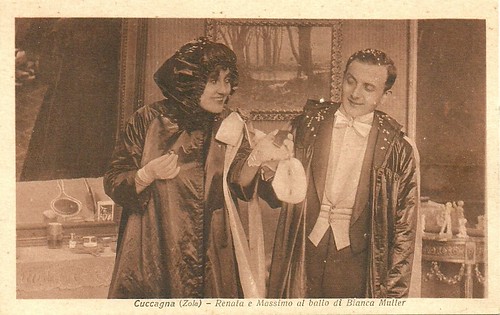
Italian postcard, no. 5073. Photo: Tiber Film. Hesperia and Alberto Collo in La cuccagna (Baldassarre Negroni, 1917). Caption: Renata and Massimo at the ball of Bianca Muller.
La cuccagna was an adaptation of Emile Zola's 'La curée'. Hesperia is Renata/Renée, second wife of the cunning and wealthy Saccard, who married young Renata for her money. She has an affair with Saccard's son Max/Massimo, played by Alberto Collo. In the end money triumphs instead of love, just as in Zola's novel.

Italian postcard, no. 5077. Photo: Tiber Film. Hesperia in La cuccagna (Baldassarre Negroni, 1917). Caption: Renata had turned Massimo in an 'viveur'.

Italian postcard by IPA CT Duplex, no. 5103. photo: Tiber Film, Roma. Tullio Carminati and Ida Carloni Talli in L'aigrette (Baldassarre Negroni, 1917).
The countess of Saint-Servant (Ida Carloni Talli) has raised her son Enrico (Tullio Carminati) to be proud of his name and title and to cherish honour and virtue, symbolised by the feather of her aigrette (egret). In reality, the countess is hunted by creditors, the castle is falling apart. Enrico falls in love with Susanne Leblanc (Hesperia), wife of a banker, and, unknowing to Enrico, in return, she loads his mother with money in order to restore the family castle and pay off the many debts. Her husband Claudio (André Habay) is not so happy with this kind of charity and reveals to Enrico that he and his mother have been living on his lover's expenses for years...
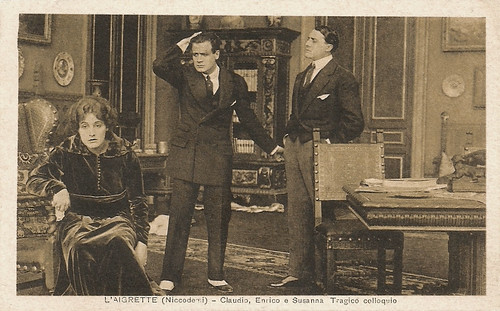
Italian postcard by IPA CT Duplex, no. 5108. Photo: Tiber Film, Hesperia, Tullio Carminati and André Habay in L'aigrette (Baldassarre Negroni, 1917). Caption: Claudio, Enrico, and Susanna. Tragic conversation.

Spanish collectors card in the Colec. cromos cinematográficos by Chocolat Imperiale, no. 1 (in a serie of 6 cromos). Photo: Tiber-Film, Roma / J. Verdaguer, Barcelona. Hesperia and André Habay in La principessa di Bagdad (Baldassarre Negroni, 1918).
Lionella (Hesperia) is the illegitimate daughter of the King of Bagdad, and recognized by her stepfather, the count of Quansas. Raised a spoiled brat, when she marries the Count Giovanni de Hun (André Habay), she squanders his richness lightly. A family friend, Nourmandy (Goffredo d'Andrea), secretly in love with Lionella, pays all debts. De Hun believes his wife and Nourmandy are lovers, so he has them arrested by the police just when she is refusing another offer by Nourmandy. Hurt in her pride by her husband's brutal behavior, Lionella decides to leave with her lover, but her little son Raul begs her to refrain from such a step. Lionella's motherly love is bigger than her pride, so she chases the lover and pays off the debts with a generous donation by the dying, and repenting King. Her husband, at last, understands everything.

Spanish collectors card in the Colec. cromos cinematográficos by Chocolat Imperiale, no. 5 (in a serie of 6 cromos). Photo: Tiber-Film, Roma / J. Verdaguer, Barcelona. Hesperia in La principessa di Bagdad (Baldassarre Negroni, 1918).

French postcard by Le Deley, Paris. Photo: U.C.I. / Gaumont / Tiber Film. Hesperia in Il figlio di Madame Sans-Gêne (Baldassarre Negroni, 1921), adapted from the novel by Emile Moreau. Here Hesperia as Madame Sans-Gêne is portrayed similarly to François Gérard's portrait of Juliette Récamier.
In Il figlio di Madame Sans-Gêne, sergeant Lefèvre (Enrico Scatizzi) meets an ironing lady (Hesperia) at a 'bal populaire' during the celebrations of the first successes of the French Revolution. They marry and have a son, Antonio. Lefèvre proves himself on the European battlefields and he becomes Marshal and Duke of Danzig. His wife becomes Madame Sans-Gêne, Duchess of Danzig. When Antonio (Carlo Troisi) has grown up, he falls in love with a young noble lady (Pauline Polaire), but she is already promised to the seigneur Ambzac, a Royalist conspirator. When the girl marries D'Ambzac, Antonio decides to flee with her and steals money from his father. When the theft is found out, Antonio asks to be sent to the battlefront as punishment.

French postcard by Le Deley, Paris. Photo: U.C.I. / Gaumont / Tiber Film. Hesperia in Il figlio di Madame Sans-Gêne (Baldassarre Negroni, 1921).

Italian postcard. Photo: Tiber Film. Hesperia and probably Carlo Troisi in La belle Madame Hebert (Baldassarre Negroni, 1922). The film was an adaptation of the homonymous French play by Abel Hermant.
Before he started Tiber Film, Gioacchino Mecheri had been the director of the Celio company. Tiber Film had its Roman studios at the Pineta Sacchetti.
Tiber Film was known for its diva dramas with Hesperia, such as Il potere sovrano/The Sovereign Power (1916), La cuccagna/The Bonanza (1917), L'aigrette/The Egret (1917), La principessa di Bagdad/The Princess of Bagdad (1918), Il figlio di Madame Sans-Gêne/The Son of Madame Sans-Gêne (1921), and La belle Madame Hebért (1922). Most of these dramas were directed by Hesperia's husband, Baldassarre Negroni.
In addition to these Diva films, Tiber Film profiled itself also with historical films serving the war propaganda. These films included Oberdan/Guglielmo Oberdan, il martire di Trieste (Emilio Ghione, 1915), and Cicueracchio (Emilio Ghione, 1915).
The studio also produced melodramas with Maria Jacobini such as Come le foglie/Like the leafs (Gennaro Righelli, 1917), and Resurrezione/Resurrection (Mario Caserini, 1917) and with Diana Karenne, like La peccatrice casta/The chaste sinner (Diana Karenne, Gennaro Righelli, 1919) and Zoya (Giulio Antamoro, 1920).
Tiber also produced the Polidor and Za-la-Mort films, including I topi grigi/The gray mice (Emilio Ghione, 1918), starring Emilio Ghione.
In 1918 the company merged with Film d'Arte Italiana and in 1919 with the Unione Cinematografia Italiana (UCI). When the latter collapsed in 1923, this also meant the end of Tiber Film.

Italian postcard. Photo: Tiber Film. Gastone Monaldi as Ciceruacchio in Ciceruacchio (Emilio Ghione, 1915). Caption: People of Rome! Do you want to bend to slavery by the stranger? No! Do you want to swear with me to die for freedom? Yes! Yes!
Angelo Brunetti, named Ciceruacchio, a Roman trader in cheese and wine, was much beloved by the Roman people, e.g. for his behaviour during the 1837 cholera plague. In a public performance in 1846, he thanked the pope Pius IX for releasing political prisoners, while in 1847 he pressed Pius IX to continue his policy of reform. During the 1848 revolution, he joined the Roman Republican forces and helped the Romans in the siege by the French. But when they were defeated in 1849, he fled with his sons Lorenzo and Luigi and hoped with Garibaldi and allies to liberate Venice from the Austrians. Instead, they were betrayed by locals at Cesenatico and then arrested and executed by the Austrians on 10 August 1849.

Italian postcard. Photo: Tiber Film. Gastone Monaldi as Ciceruacchio and Alberto Collo as his son Luigi, just before they are executed by the Austrian army in Ciceruacchio (Emilio Ghione, 1915). Caption: And Ciceruacchio said: Luigi, my son! Let your courage at this moment be the same as when I separated you from your mother. Like never before, the ardent faith of the fatherland will bring you happily to your death.

Italian postcard. Photo: Tiber Film. Alberto Collo as Oberdan, and Ida Carloni Talli as his mother in Guglielmo Oberdan, il martire di Trieste (Emilio Ghione 1915). Caption: And his mother said: Go! My most beloved one, remember every suffered insult, every cry of grief. Make sure that the Fatherland will be saved.
In 1882, Guglielmo Oberdan was executed after a failed attempt to assassinate Austrian Emperor Francis Joseph. He became a martyr of the Italian unification movement. Thirty years later, silent film star Alberto Collo played him in Guglielmo Oberdan, il martire di Trieste (Emilio Ghione, 1915), produced by Tiber Films during World War I.

Italian postcard. Photo: Tiber Film. Alberto Collo in Guglielmo Oberdan, il martire di Trieste (Emilio Ghione, 1915). Caption: Italy! May I see you again having grown bigger... or never see you again.
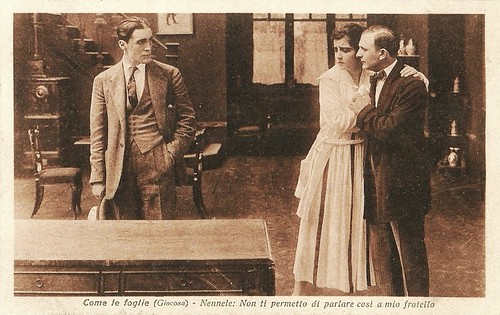
Italian postcard. Photo: Tiber Film, Roma. Guido Guiducci as Massimo, Maria Jacobini as Nennele and Alberto Collo as her brother Tommy in Come le foglie (Gennaro Righelli, 1917). Caption: I won't allow you to speak about my brother in this way.
After a life of spendthrifts, the Rosati (Rosani with Giacosa) family is ruined. Father Giovanni (Ignazio Lupi) accepts work from his cousin Massimo (Guido Guiducci) in Switzerland. Hitherto neglected as too serious and workaholic, Massimo becomes the head of the family and takes care of the son and daughter of Giovanni, Tommy (Alberto Collo) and Nennele (Maria Jacobini), and their stepmother Giulia (Floriana). Tommy and Giulia remain weak spirits. Giulia has an affair with a painter called Helmer, and when none of her own paintings are sold, she tries to steal the golden frame from one of Nennele's paintings. Tommy's idleness is like a dead leaf. He fails two managing jobs arranged by Massimo. Because of his gambling debts with the Russian countess Orloff's gambling table, he is forced to marry her. Massimo proposes to Nennele, advising her not to rebel 'against the wind that blows the leaves', but she refuses him. She is so devastated by her brother and stepmother, she intends to commit suicide, but her father prevents this and unites Nennele with Massimo, who has come to help once more.

Italian postcard. Photo: Tiber Film, Roma. Maria Jacobini in Come le foglie (Gennaro Righelli, 1917). The man in the middle could be Alberto Collo. Caption: The portrait slipped from the package and fell to the ground.
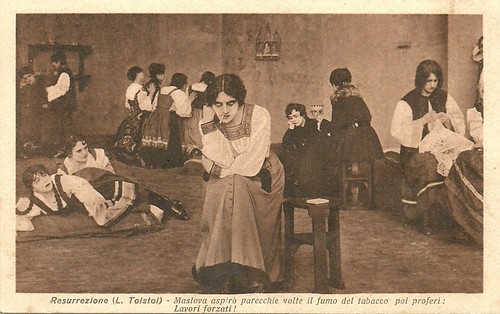
Italian postcard. Photo: Tiber Film. Maria Jacobini in Resurrezione (Mario Caserini, 1917), based on Leo Tolstoy's novel. Caption: Maslova inhaled the tobacco's smoke a few times, then uttered: Forced labour!

Italian postcard. Photo: Tiber Film. Maria Jacobini in Resurrezione (Mario Caserini, 1917), based on Leo Tolstoy's novel. Caption: On 17 January in a room of Hotel Mauritania, Smielkov suddenly died.

Spanish cromo by Chocolat Imperiale, Barcelona, no. 3 of 6. Photo: Tiber Film / Verdaguer. Diana Karenne and Alberto Pasquali in La peccatrice casta (Diana Karenne, Gennaro Righelli, 1919).
Wanda (Diana Karenne) is a popular dancer, but very ill. When she collapses during a performance, a count (Alberto Pasquali), comes to aid, falls in love with her, and wants to marry her. Wanda accepts but after the wedding she returns to dancing and her mundane life starts again, which she never could say goodbye to. She ends up falling for another man (Mario Parpagnoli), while her husband, after finding out, bitterly leaves for the US. One year after, the husband returns and finds her alone, with a child, and left by her lover. He reunites with her, pardons her, and accepts the child too.

Spanish cromo by Chocolat Imperiale, Barcelona, no. 6 of 6. Photo: Tiber Film / Verdaguer. Diana Karenne in La peccatrice casta (Diana Karenne, Gennaro Righelli, 1919).

Italian postcard by Vettori, Bologna. Photo: Tiber Film. Diana Karenne in Zoya/Zoja (Giulio Antamoro, 1920). The man left might be Mario Parpagnoli.

Italian postcard by Vettori, Bologna, no. 2011. Photo: Tiber Film / U.C.I. Emilio Ghione in Senza pietà (Emilio Ghione, 1921).
Sources: Vittorio Martinelli (Il cinema muto italiano, Vol. 1915, 1916, 1917, 1918, 1921-22), Vittorio Martinelli (Za la Mort. Ritratto di Emilio Ghione), and Wikipedia (Italian).

Spanish collectors card by Chocolate Pi, Barcelona, no. 2 of 6. Photo: Tiber Film. Hesperia and Emilio Ghione in Il potere sovrano (Baldassarre Negroni, Percy Nash, 1916).
Il potere sovrano was based on the novel 'Temporal Power' by Marie Corelli. Lotys (Hesperia) is the idol of the people. Therd (Emilio Ghione), a journalist, a man of action, and manager of the paper The Idea, is also beloved by his compatriots. Their ideals unite Lotys and Therd. The King (Ignazio Lupi) lives distanced from his people and has left governing to his ministers. The government threatens Therd with arrest if he doesn't stop his actions.

Spanish collectors card by Chocolate Pi, Barcelona, no. 6 of 6. Photo: Tiber Film. Hesperia and Emilio Ghione in Il potere sovrano (Baldassarre Negroni, Percy Nash, 1916).

Spanish cromo card by Chocolate Pi, Barcelona, no. 2 of 6 cards. Photo: Tiber-Film, Roma / J. Verdaguer, Barcelona. Hesperia and Tullio Carminati in La donna abbandonata (Baldassarre Negroni, 1917).
A Parisian 'viveur' is fed of his life and withdraws to a family castle in the countryside. There he sees a mysterious lady, who leads a withdrawn life. Intrigued, he invents a ruse to meet her. She tells him her sorrowful past... The plot was based on a novella by Balzac, but the Italian press found the story too static and interiorised for the medium of film.

Spanish cromo card by Chocolate Pi, Barcelona, no. 4 of 6 cards. Photo: Tiber-Film, Roma / J. Verdaguer, Barcelona. Hesperia in La donna abbandonata (Baldassarre Negroni, 1917).

Italian postcard, no. 5073. Photo: Tiber Film. Hesperia and Alberto Collo in La cuccagna (Baldassarre Negroni, 1917). Caption: Renata and Massimo at the ball of Bianca Muller.
La cuccagna was an adaptation of Emile Zola's 'La curée'. Hesperia is Renata/Renée, second wife of the cunning and wealthy Saccard, who married young Renata for her money. She has an affair with Saccard's son Max/Massimo, played by Alberto Collo. In the end money triumphs instead of love, just as in Zola's novel.

Italian postcard, no. 5077. Photo: Tiber Film. Hesperia in La cuccagna (Baldassarre Negroni, 1917). Caption: Renata had turned Massimo in an 'viveur'.

Italian postcard by IPA CT Duplex, no. 5103. photo: Tiber Film, Roma. Tullio Carminati and Ida Carloni Talli in L'aigrette (Baldassarre Negroni, 1917).
The countess of Saint-Servant (Ida Carloni Talli) has raised her son Enrico (Tullio Carminati) to be proud of his name and title and to cherish honour and virtue, symbolised by the feather of her aigrette (egret). In reality, the countess is hunted by creditors, the castle is falling apart. Enrico falls in love with Susanne Leblanc (Hesperia), wife of a banker, and, unknowing to Enrico, in return, she loads his mother with money in order to restore the family castle and pay off the many debts. Her husband Claudio (André Habay) is not so happy with this kind of charity and reveals to Enrico that he and his mother have been living on his lover's expenses for years...

Italian postcard by IPA CT Duplex, no. 5108. Photo: Tiber Film, Hesperia, Tullio Carminati and André Habay in L'aigrette (Baldassarre Negroni, 1917). Caption: Claudio, Enrico, and Susanna. Tragic conversation.

Spanish collectors card in the Colec. cromos cinematográficos by Chocolat Imperiale, no. 1 (in a serie of 6 cromos). Photo: Tiber-Film, Roma / J. Verdaguer, Barcelona. Hesperia and André Habay in La principessa di Bagdad (Baldassarre Negroni, 1918).
Lionella (Hesperia) is the illegitimate daughter of the King of Bagdad, and recognized by her stepfather, the count of Quansas. Raised a spoiled brat, when she marries the Count Giovanni de Hun (André Habay), she squanders his richness lightly. A family friend, Nourmandy (Goffredo d'Andrea), secretly in love with Lionella, pays all debts. De Hun believes his wife and Nourmandy are lovers, so he has them arrested by the police just when she is refusing another offer by Nourmandy. Hurt in her pride by her husband's brutal behavior, Lionella decides to leave with her lover, but her little son Raul begs her to refrain from such a step. Lionella's motherly love is bigger than her pride, so she chases the lover and pays off the debts with a generous donation by the dying, and repenting King. Her husband, at last, understands everything.

Spanish collectors card in the Colec. cromos cinematográficos by Chocolat Imperiale, no. 5 (in a serie of 6 cromos). Photo: Tiber-Film, Roma / J. Verdaguer, Barcelona. Hesperia in La principessa di Bagdad (Baldassarre Negroni, 1918).

French postcard by Le Deley, Paris. Photo: U.C.I. / Gaumont / Tiber Film. Hesperia in Il figlio di Madame Sans-Gêne (Baldassarre Negroni, 1921), adapted from the novel by Emile Moreau. Here Hesperia as Madame Sans-Gêne is portrayed similarly to François Gérard's portrait of Juliette Récamier.
In Il figlio di Madame Sans-Gêne, sergeant Lefèvre (Enrico Scatizzi) meets an ironing lady (Hesperia) at a 'bal populaire' during the celebrations of the first successes of the French Revolution. They marry and have a son, Antonio. Lefèvre proves himself on the European battlefields and he becomes Marshal and Duke of Danzig. His wife becomes Madame Sans-Gêne, Duchess of Danzig. When Antonio (Carlo Troisi) has grown up, he falls in love with a young noble lady (Pauline Polaire), but she is already promised to the seigneur Ambzac, a Royalist conspirator. When the girl marries D'Ambzac, Antonio decides to flee with her and steals money from his father. When the theft is found out, Antonio asks to be sent to the battlefront as punishment.

French postcard by Le Deley, Paris. Photo: U.C.I. / Gaumont / Tiber Film. Hesperia in Il figlio di Madame Sans-Gêne (Baldassarre Negroni, 1921).

Italian postcard. Photo: Tiber Film. Hesperia and probably Carlo Troisi in La belle Madame Hebert (Baldassarre Negroni, 1922). The film was an adaptation of the homonymous French play by Abel Hermant.
Diva Dramas and Propaganda films
Before he started Tiber Film, Gioacchino Mecheri had been the director of the Celio company. Tiber Film had its Roman studios at the Pineta Sacchetti.
Tiber Film was known for its diva dramas with Hesperia, such as Il potere sovrano/The Sovereign Power (1916), La cuccagna/The Bonanza (1917), L'aigrette/The Egret (1917), La principessa di Bagdad/The Princess of Bagdad (1918), Il figlio di Madame Sans-Gêne/The Son of Madame Sans-Gêne (1921), and La belle Madame Hebért (1922). Most of these dramas were directed by Hesperia's husband, Baldassarre Negroni.
In addition to these Diva films, Tiber Film profiled itself also with historical films serving the war propaganda. These films included Oberdan/Guglielmo Oberdan, il martire di Trieste (Emilio Ghione, 1915), and Cicueracchio (Emilio Ghione, 1915).
The studio also produced melodramas with Maria Jacobini such as Come le foglie/Like the leafs (Gennaro Righelli, 1917), and Resurrezione/Resurrection (Mario Caserini, 1917) and with Diana Karenne, like La peccatrice casta/The chaste sinner (Diana Karenne, Gennaro Righelli, 1919) and Zoya (Giulio Antamoro, 1920).
Tiber also produced the Polidor and Za-la-Mort films, including I topi grigi/The gray mice (Emilio Ghione, 1918), starring Emilio Ghione.
In 1918 the company merged with Film d'Arte Italiana and in 1919 with the Unione Cinematografia Italiana (UCI). When the latter collapsed in 1923, this also meant the end of Tiber Film.

Italian postcard. Photo: Tiber Film. Gastone Monaldi as Ciceruacchio in Ciceruacchio (Emilio Ghione, 1915). Caption: People of Rome! Do you want to bend to slavery by the stranger? No! Do you want to swear with me to die for freedom? Yes! Yes!
Angelo Brunetti, named Ciceruacchio, a Roman trader in cheese and wine, was much beloved by the Roman people, e.g. for his behaviour during the 1837 cholera plague. In a public performance in 1846, he thanked the pope Pius IX for releasing political prisoners, while in 1847 he pressed Pius IX to continue his policy of reform. During the 1848 revolution, he joined the Roman Republican forces and helped the Romans in the siege by the French. But when they were defeated in 1849, he fled with his sons Lorenzo and Luigi and hoped with Garibaldi and allies to liberate Venice from the Austrians. Instead, they were betrayed by locals at Cesenatico and then arrested and executed by the Austrians on 10 August 1849.

Italian postcard. Photo: Tiber Film. Gastone Monaldi as Ciceruacchio and Alberto Collo as his son Luigi, just before they are executed by the Austrian army in Ciceruacchio (Emilio Ghione, 1915). Caption: And Ciceruacchio said: Luigi, my son! Let your courage at this moment be the same as when I separated you from your mother. Like never before, the ardent faith of the fatherland will bring you happily to your death.

Italian postcard. Photo: Tiber Film. Alberto Collo as Oberdan, and Ida Carloni Talli as his mother in Guglielmo Oberdan, il martire di Trieste (Emilio Ghione 1915). Caption: And his mother said: Go! My most beloved one, remember every suffered insult, every cry of grief. Make sure that the Fatherland will be saved.
In 1882, Guglielmo Oberdan was executed after a failed attempt to assassinate Austrian Emperor Francis Joseph. He became a martyr of the Italian unification movement. Thirty years later, silent film star Alberto Collo played him in Guglielmo Oberdan, il martire di Trieste (Emilio Ghione, 1915), produced by Tiber Films during World War I.

Italian postcard. Photo: Tiber Film. Alberto Collo in Guglielmo Oberdan, il martire di Trieste (Emilio Ghione, 1915). Caption: Italy! May I see you again having grown bigger... or never see you again.

Italian postcard. Photo: Tiber Film, Roma. Guido Guiducci as Massimo, Maria Jacobini as Nennele and Alberto Collo as her brother Tommy in Come le foglie (Gennaro Righelli, 1917). Caption: I won't allow you to speak about my brother in this way.
After a life of spendthrifts, the Rosati (Rosani with Giacosa) family is ruined. Father Giovanni (Ignazio Lupi) accepts work from his cousin Massimo (Guido Guiducci) in Switzerland. Hitherto neglected as too serious and workaholic, Massimo becomes the head of the family and takes care of the son and daughter of Giovanni, Tommy (Alberto Collo) and Nennele (Maria Jacobini), and their stepmother Giulia (Floriana). Tommy and Giulia remain weak spirits. Giulia has an affair with a painter called Helmer, and when none of her own paintings are sold, she tries to steal the golden frame from one of Nennele's paintings. Tommy's idleness is like a dead leaf. He fails two managing jobs arranged by Massimo. Because of his gambling debts with the Russian countess Orloff's gambling table, he is forced to marry her. Massimo proposes to Nennele, advising her not to rebel 'against the wind that blows the leaves', but she refuses him. She is so devastated by her brother and stepmother, she intends to commit suicide, but her father prevents this and unites Nennele with Massimo, who has come to help once more.

Italian postcard. Photo: Tiber Film, Roma. Maria Jacobini in Come le foglie (Gennaro Righelli, 1917). The man in the middle could be Alberto Collo. Caption: The portrait slipped from the package and fell to the ground.

Italian postcard. Photo: Tiber Film. Maria Jacobini in Resurrezione (Mario Caserini, 1917), based on Leo Tolstoy's novel. Caption: Maslova inhaled the tobacco's smoke a few times, then uttered: Forced labour!

Italian postcard. Photo: Tiber Film. Maria Jacobini in Resurrezione (Mario Caserini, 1917), based on Leo Tolstoy's novel. Caption: On 17 January in a room of Hotel Mauritania, Smielkov suddenly died.

Spanish cromo by Chocolat Imperiale, Barcelona, no. 3 of 6. Photo: Tiber Film / Verdaguer. Diana Karenne and Alberto Pasquali in La peccatrice casta (Diana Karenne, Gennaro Righelli, 1919).
Wanda (Diana Karenne) is a popular dancer, but very ill. When she collapses during a performance, a count (Alberto Pasquali), comes to aid, falls in love with her, and wants to marry her. Wanda accepts but after the wedding she returns to dancing and her mundane life starts again, which she never could say goodbye to. She ends up falling for another man (Mario Parpagnoli), while her husband, after finding out, bitterly leaves for the US. One year after, the husband returns and finds her alone, with a child, and left by her lover. He reunites with her, pardons her, and accepts the child too.

Spanish cromo by Chocolat Imperiale, Barcelona, no. 6 of 6. Photo: Tiber Film / Verdaguer. Diana Karenne in La peccatrice casta (Diana Karenne, Gennaro Righelli, 1919).

Italian postcard by Vettori, Bologna. Photo: Tiber Film. Diana Karenne in Zoya/Zoja (Giulio Antamoro, 1920). The man left might be Mario Parpagnoli.

Italian postcard by Vettori, Bologna, no. 2011. Photo: Tiber Film / U.C.I. Emilio Ghione in Senza pietà (Emilio Ghione, 1921).
Sources: Vittorio Martinelli (Il cinema muto italiano, Vol. 1915, 1916, 1917, 1918, 1921-22), Vittorio Martinelli (Za la Mort. Ritratto di Emilio Ghione), and Wikipedia (Italian).
No comments:
Post a Comment